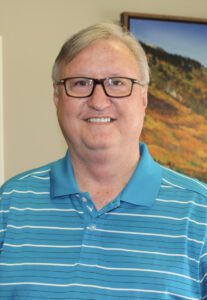25 Jun 2018 Patterson demonstrates real eye for photography
by Dwain Hebda
As an optometrist, Dr. Bill Patterson has made a career out of helping people see better, having spent 30 years in practice and the last nine at his present location on Donaghey Avenue.
As a photographer, he’s done much the same thing.
“It’s where I get to express my artistic side,” he said of the massive photographs that occupy every wall of the clinic. “You’re painting with light, really, which is the only way I can be an artist. I can’t draw a straight line. It’s really all about the lighting.”
Patterson’s business has many stunning landscapes and delicate plant life portraits. Over there a mighty Colorado mountain shimmers, reflected in a crystal-clear lake; over here the Utah desert greets the dawn, its red and orange rocks almost extraterrestrial in appearance.
Patterson’s interest in photography began in high school. Equally avid an athlete as he was a reader of Sports Illustrated, he was captivated by the images the magazine captured.
“I just had this niche for sports and photography,” he said. “I was fascinated by them capturing that event and how they did it.”
He pushed the hobby aside during his years at college and optometry school, only to rekindle it after his two sons were born, shooting the usual events and activities that make up family life.
“When the digital age came, I jumped onboard with that pretty early,” he said. “I saw that that was going to be a good thing. My first digital camera was the very first Canon Rebel in about 2006, and that was it.”
Digital equipment gave him wider creativity and traveled better, thus inspiring Patterson to seek out the natural and wild places that quickly became his forte. He’s never taken a formal photography class, instead forming a network of fellow enthusiasts who are both traveling companions and help desk.
“I’m a member of the Arkansas Outdoor Photography Club in Little Rock, and they have one in Conway, too, so I’ve done some of that,” he said. “My photo buddies and I, we help each other out.”
Patterson initially moved into his current office in 2009 without the idea of decorating it with the images he has captured. The first one he hung up — wild violets growing out of a Buffalo River oak stump — opened the door for a landslide of other images.
“At first, everything in the office was from Arkansas, mostly in the 501 area,” he said. “But then I’d go to these other places and people who knew me would say, ‘Well, tell me about your trip to Colorado.’ And I’d show them, and they’d say, ‘You need to put some of those pictures up.’ It just kind of evolved from there.”
 Over the years, Patterson has developed some hard and fast rules when shooting on location. First, when visiting a place of interest, he gets the usual tourist snaps out of the way before heading out to practice his art. Second, he’s learned to let the photo present itself; nature works by its own rules and timetables, and trying to get it to conform to too rigid a plan rarely works.
Over the years, Patterson has developed some hard and fast rules when shooting on location. First, when visiting a place of interest, he gets the usual tourist snaps out of the way before heading out to practice his art. Second, he’s learned to let the photo present itself; nature works by its own rules and timetables, and trying to get it to conform to too rigid a plan rarely works.
“Most of the true pictures that really surprise me, the intent was to go to that area, but the pictures you can’t really plan,” he said. “The best pictures come out in the least likely places. If you plan a picture too closely, it just never measures up.”
Not that Patterson isn’t just stubborn enough to go to certain lengths to make sure he’s in generally the right spot at about the right time. Throughout his career, he’s amassed volumes of stories about what it took to get this shot or that. An inopportune gust of wind nearly blew him off an Arizona cliff once; another time, he got a little too close to an alligator in the Flordia Everglades.
But he’s always returned, more or less intact, with a great tale and thousands more frames from all over the United States in all kinds of ecosystems. He’s still got a couple of places yet on his list to shoot, but even if he doesn’t get there, he could shoot his favorite spots — Colorado and Arkansas, namely — for the rest of his days and be happy with the result.
“I’ve never done Alaska and Hawaii. And because of the crowds, I haven’t gone much to the Northeast, and I know I need to do that. I saw enough up there to know I’ve got to go back one day,” he said. “But from a relaxing standpoint, you go out to the West and it’s just so wide open you get your peace and quiet while you’re there.”
Patterson also has a particular fondness for the 501. “I also can’t get enough of the Buffalo River and Garvan Gardens when the tulips are in bloom. Those two things are just classic to me.”
- The pinnacle of success - June 1, 2025
- Five-Oh-Ones to Watch 2025: Aaron Farris - December 31, 2024
- Julia Gaffney brings medals and mettle home to Mayflower - October 30, 2024


















